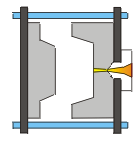We will be closed from Friday 12/20/24 until Monday 01/06/25. Celebrating Joy and Unity as the holiday season approaches, Kinetic Die Casting Company extends warm wishes to our valued customers, partners, employees, and friends. Christmas is a time of joy, …
Continue reading
Category Archives: Die Casting Alloys
The Advantages of Aluminum Golf Products over Steel 2020
The Advantages of Aluminum Golf Products Over Steel. Presently, more and more golfing and sporting stores are selling aluminum golf products. Compared to steel, aluminum is lighter. Because of its lightness, aluminum has been increasingly used in manufacturing shafts for golf clubs. Lighter shafts allow manufacturers of golf products to come up with slightly heavier golf heads. Since aluminum is not as heavy as steel, aluminum shafts enable golfers to swing faster and increase the ball’s distance with each shot. Additionally, despite its lightness, aluminum shafts still allow clubs to keep the optimal weighting needed for good balance. Like aluminum, there are certain types of steel that also provide golfers with a good feel. However, these steel types don’t really create the ball compression needed by golfers to achieve maximum ball distance.
Aluminum is also cheaper to produce and easier to mold than steel. Additionally, aluminum parts can be manufactured faster with less labor compared to steel. Many aluminum golf products include golf heads that are die cast in aluminum alloy, which is extremely hard and is appropriate for golf head production. In relation to cost, aluminum golf products are generally cheaper than those made from steel. Examples of golf products made from aluminum or with aluminum parts include golf carts with aluminum brackets, handles, and knobs, golf trolleys made with durable aviation-grade aluminum frames, golf retrievers, and golf ball heaters.
To get a price for aluminum die casting parts or die casting tooling, call toll free 800-524-8083 and ask for sales. Or email us at sales@kineticdc.com for a fast response on a price quote.

Kinetic Die Casting manufactures a lot of aluminum rooftile plates , trim tile molds, and military die casting. If you would like a quote, please visit our website: Kinetic Die Casting Company
Three of the Most Popular Die Casting Alloys 2019
Three of the Most Popular Die Casting Alloys. Aluminum is the most accepted out of all die casting alloys. Besides its lightweight features and its sturdy ability, aluminum is also found to be very inexpensive measured up to other die casting alloys. When choosing the ideal material to utilize in die casting, it is vital to have concise information as to how each alloy is different from one another. Although aluminum may have a lot of benefits and advantages compared to other materials, some die casting companies also prefer not to use aluminum owing to its high shrinkage capability and also its receptivity to high temperature.
Copper is one of the various other die casting alloys like zinc die casting available in the scientific procedure. One of the advantages of employ copper is its inflexibility and its ability to decrease ductility. Copper is also identified not be receptacle to corrosion, generating an outstanding substitute to aluminum. On the other hand, if you are looking for a type of alloy that is able to work on narrower walls compared to the effectiveness of aluminum, you can also use Zinc as an alternative. Zinc has the capability to close tolerances because of its fluidic nature that is highly influenced by high temperatures. When die casters decided Zinc as its die casting alloy, the casting is processed at a lower temperature than usual so as not to completely melt the die. As soon as the die is shaped, it is much easier for die casters to permit the result to solidify due to the material’s sensitivity towards temperature.
Die Casting Alloys
Die Casting Alloys
Die Casting Metals and Technical Terms
Die Casting Technical Information
Die Casting Aluminum Parts
Die Casting Zinc Parts
Kinetic Die Casting Company 6918 Beck Avenue, North Hollywood, California 91605 USA
E-mail sales@kineticdc.com Toll Free: (800) 524-8083 Local: (818) 982-9200 Fax: (818) 982-0877
Die Casting Parts Prices
Die Casting Process
Kinetic Die Casting Company uses the die casting process to make aluminum die castings and zinc die casting parts. The die casting process, simplified, is described as follows:
- Our customer provides us tooling (https://www.kineticdiecasting.com/tooling.html), a die, a mold or inserts that we use to make their parts. We can also produce the tooling for our customers.
- We put together the tooling and mount the tooling in our die casting machine. This takes a few hours.
- We fill a furnace with the proper die casting alloy metal (https://www.kineticdiecasting.com/Alloy_Data.pdf) to make the parts for our customer. The metal takes 4 hours to melt to the casting temperature.
- While the furnace is heating up we heat up the tooling to make the castings.
- When the tooling is hot and the furnace has melted the aluminum, we begin the die casting process.
- We spray the tooling with a release agent so the parts do not stick in the tooling.
- We close the tooling inside our die casting machine.
- The metal is ladled into a shot sleeve, a piston drives the metal into the tooling using great force.
- Our die casting machine opens, the ejector pins push the part out of the tooling
- We begin the process again by spraying the tooling.
- We repeat this process 200 times to 500 times in a 10 hour shift.
- When completed making raw castings, we trim the excess material called “flash”. We use a trim die in a trim press or we sand parts with a belt sander and file them by hand. Sometimes this takes longer than the casting process.
- At this point, some parts are put in boxes and shipped the same day. Other parts are machined. Some parts get painted or chemical coated. All parts are inspected prior to shipping to our customers.
This is a very simplified description of the die casting manufacturing process.
“The Parts We Make Today, We Ship Today”
Kineticdc makes:
What is Die Casting
Die Casting Part Pictures
Quote Die Casting Part Prices
Diecast Tooling
Kinetic Die Casting Company 6918 Beck Avenue, North Hollywood, California 91605 USA
E-mail sales@kineticdc.com Toll Free: (800) 524-8083 Local: (818) 982-9200 Fax: (818) 982-0877
Permalink: https://www.kineticdiecasting.com/kdc/die-casting-process/



